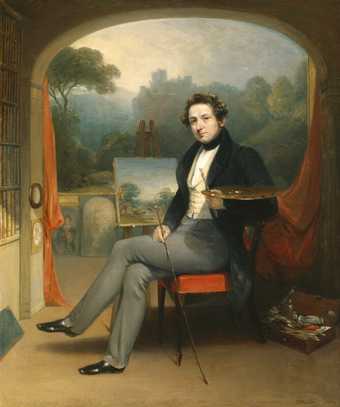University of York
Supervised by Dr Richard Johns, Lecturer in History of Art, University of York and Dr Martin Myrone, Lead Curator (British Art to 1800), Tate
October 2017 –

George Arnald
George Arnald 1831
oil on canvas
NPG 5254
© National Portrait Gallery, London
After the establishment of the Royal Academy in 1768, London experienced an ‘age of exhibitions’, a new social culture that changed the artistic economy. In response, artist’s roles, motivations and inspiration were changing. So to their studios adapted to accommodate patrons, exhibit work, mould their identity and reflect their professionalism, and be a location of creativity. Due to the lack of research, landscape paintings are currently interpreted, potentially inaccurately, based on understandings of the studios of artists of other genres. This thesis explores what scholarship has overlooked: the irony that rural landscapes were being painted in urban London, the outside world being created inside the limits of a room. By building a visual, material and theoretical understanding of the landscape artist’s studio we can reshape the foundation on which we interpret the landscapes produced in those spaces. Where were their studios situated? What were their studios like? How did the artists adapt them for landscape painting and, in turn, how did this impact the landscape paintings themselves?
The research is broken down into quantitative and qualitative methods, triangulating data from a GIS map, a database of landscape artists in London and case studies. Each approach will corroborate the accuracy of what is show in visual sources. The case studies will reveal what life was like for the typical landscape artists: George Arnald (successful but forgotten), Harriet Gouldsmith (providing insight into the life of female landscape artists), George Morland (socially notorious and still remembered) and John Constable (whose posthumous increasing fame knows no bounds). This thesis seeks to expose how the landscape artists’ studio was the location of a thriving urban culture which has been underestimated by scholarship to date.
How did you come to be researching this subject?
As an avid painter when I was a student, I became fascinated with how artists achieved such technical feats before the days of photography and acrylic paint. I wanted to understand the spaces and circumstances in which individuals excelled to hang on the walls of the Royal Academy or became household names and, by contrast, those who fell into obscurity. Artists are often worshipped for their skill, beyond the realms of the individual, but I believe that by introducing audiences to the studio space anyone can relate to a great artist and their work on a human level. The artist’s studio (the space, its contents, and how it was used) can tell us so much about the artist, breaking down the barrier between the viewer and the artist’s work.
About Rhian Addison
I have been a curator for eight years, predominantly focusing on British art between 1700 and 1950. My training and experience has been practical: designing and project managing exhibitions, working with conservators to care for collections, cataloguing and loaning works for exhibition. Working on exhibitions can be very fast paced, a brilliant opportunity to gain a huge amount of detailed knowledge, however it always means moving onto the next project. I decided to pursue a PhD to delve further into my interests and improve my research skills. With this experience I intend to return to curating. I am fortunate to be funded by the AHRC as a collaborative PhD student between Tate and the University of York, giving me the unique opportunity to work closely with Tate’s collections and staff knowledge.
A selection of the exhibitions I have curated:
Cozens and Cozens (June 2017 – June 2018), The Whitworth, University of Manchester
South Asian Modernists 1953–63 (September 2017 – April 2018), The Whitworth, University of Manchester
Watts Landscapes (Feb – June 2016), Watts Gallery, Artists’ Village
Liberating Fashion: Aesthetic Dress in Victorian Portraits (Feb – June 2015), Watts Gallery, Artists’ Village
Close Up & Personal: Victorians & Their Photographs (June – November 2016), Watts Gallery, Artists’ Village
Publications:
‘Turner’s Tatham’ [forthcoming]
‘The up-springing stem of the neck’ in G F Watts’s paintings’, Visual Culture in Britain [publication forthcoming]
‘Protecting digital cultural assets: a review of the export process and supporting mechanisms’, OGL The National Archives. April 2019. Accessible via https://www.nationalarchives.gov.uk/documents/protecting-digital-cultural-assets-report.pdf
‘The Educators of Trees: Alexander and John Robert Cozens’. The Whitworth, June 2017. Accessible via http://documents.manchester.ac.uk/display.aspx?DocID=32832
Addison, Rhian. & Hilary Underwood, Liberating Fashion: Aesthetic Dress in Victorian Portraits (Surrey: Watts Gallery, 2015)
Gould, Veronica Franklin & Keremi Gawade, Ellen Terry: The Painter’s Actress. Nicholas Tromans and Rhian Addison eds. (Surrey: Watts Gallery, 2014)
Twitter @RhianLAddison
